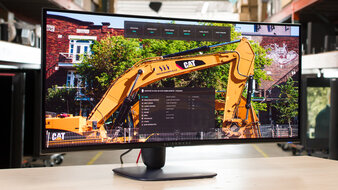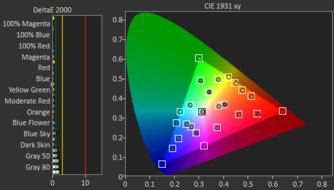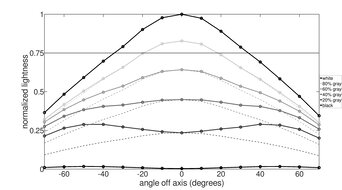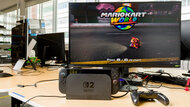Using a curved monitor for gaming has a few benefits. They're great choices if you sit close to the screen and find that the edges on flat monitors often look washed out. A curved screen brings the edges closer to your field of vision, so you see a more consistent image across the display compared to a flat screen. Not all curved gaming monitors are created equal, as they're available in different aspect ratios and sizes, with many of them being ultrawide displays. Even the shape of the curve changes from monitor to monitor. Its curve radius tells you how aggressive the curvature is, with a lower number representing a more aggressive curve; 800R is more aggressive than 1700R, but it may take some time to get used to an aggressive screen. While there's a variety of curved gaming monitors available, they aren't as common as flat monitors, though.
If you want the best gaming experience when looking for a curved monitor, it's important to consider its gaming performance and features, like its refresh rate, response time, and input lag, but most monitors have low input lag anyway. We measure for these various aspects through our extensive testing with nearly 400 tests completed on each monitor we review.
We've bought and tested more than 365 monitors, and below are our picks for the best curved gaming monitors. For more options, see our recommendations for the best curved monitors, the best 34-49 inch monitors, and the best ultrawide gaming monitors.
Quick Look
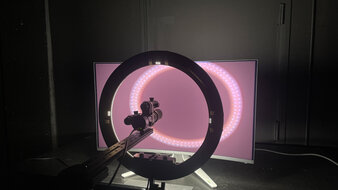




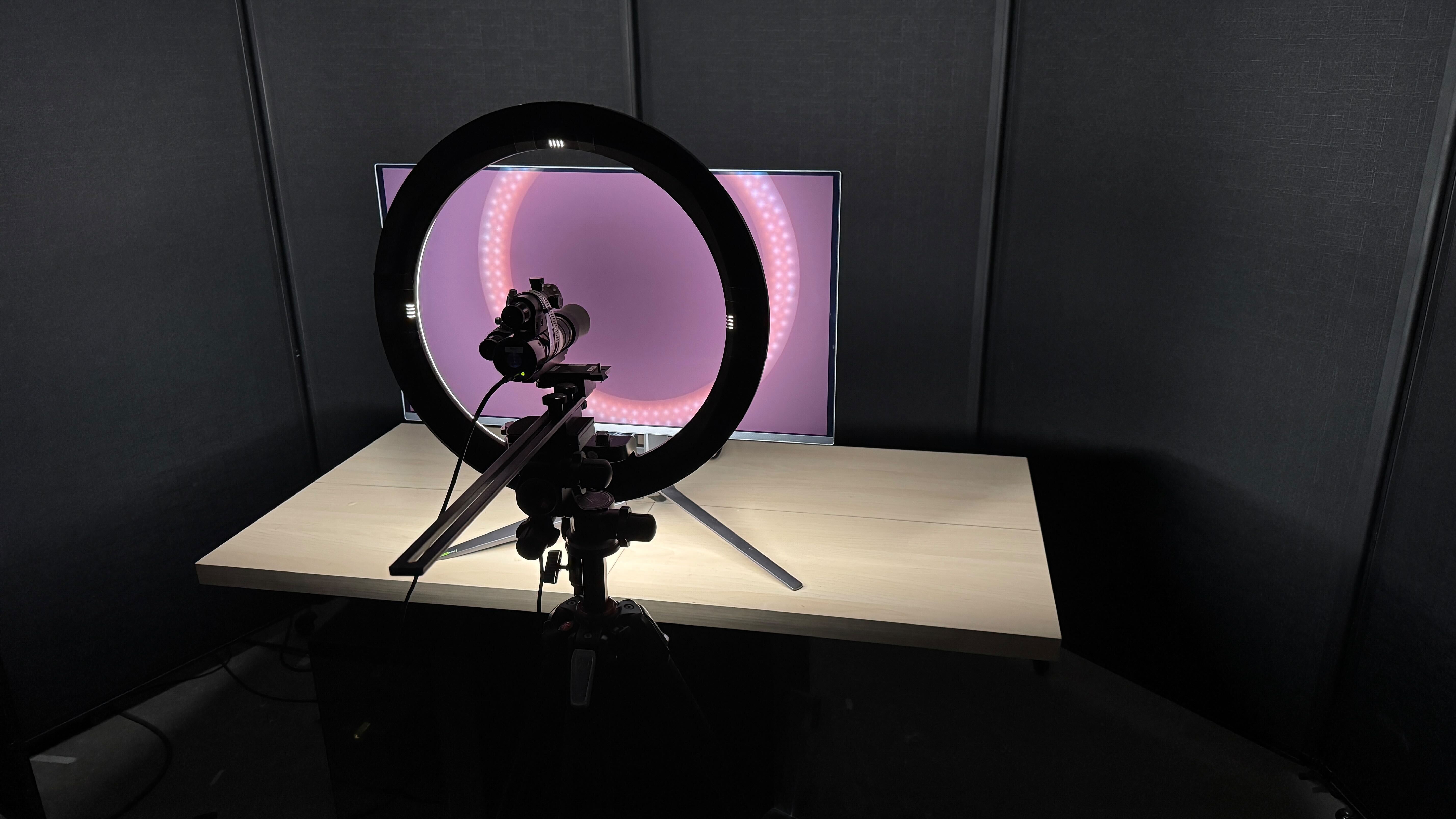
We buy and test more than 30 monitors each year, with units that we buy completely on our own, without any cherry-picked units or samples. We put a lot into each unbiased, straight-to-the-point review, and there's a whole process from purchasing to publishing, involving multiple teams and people. We do more than just use the monitor for a week; we use specialized and custom tools to measure various aspects with objective data-based results. We also consider multiple factors before making any recommendations, including the monitor's cost, its performance against the competition, and whether or not it's easy to find.
Best Curved Gaming Monitor
 PC Gaming9.0Console Gaming9.0Response Time9.7HDR Picture9.4SDR Picture10Brightness6.8Size32"Pixel TypeQD-OLEDMax Refresh Rate240 HzNative Resolution3840 x 2160See all our test resultsCurve Radius1700R
PC Gaming9.0Console Gaming9.0Response Time9.7HDR Picture9.4SDR Picture10Brightness6.8Size32"Pixel TypeQD-OLEDMax Refresh Rate240 HzNative Resolution3840 x 2160See all our test resultsCurve Radius1700RThe best curved gaming monitor we've tested is the Dell Alienware AW3225QF. It's a premium display that's outstanding for gaming. If you can't find it available with any retailer, you can get it directly through Dell's website. It has a 240Hz refresh rate and a near-instantaneous response time, meaning there's almost no blur trail behind fast-moving objects. It also supports all common types of VRR to reduce screen tearing, and has HDMI 2.1 bandwidth that takes advantage of gaming consoles. Its high 4k resolution delivers sharp images, and the screen's 1700R curve helps provide a more immersive feel compared to a flat display.
On top of its outstanding gaming performance, it even delivers exceptional picture quality. It uses a QD-OLED panel that displays perfect black levels in dark rooms and offers a wide range of colors, making highlights pop and colors look vivid. QD-OLEDs aren't perfect, though, as the picture quality is worse in bright rooms, with raised black levels and desaturated colors. Reflections also look a bit distracting in bright rooms, so it's best to use this monitor in a dim or dark room to get the best performance.
Best Upper Mid-Range Curved Gaming Monitor
 PC Gaming9.1Console Gaming9.1Response Time9.8HDR Picture9.4SDR Picture10Brightness6.8Size34"Pixel TypeQD-OLEDMax Refresh Rate240 HzNative Resolution3440 x 1440See all our test resultsCurve Radius1800R
PC Gaming9.1Console Gaming9.1Response Time9.8HDR Picture9.4SDR Picture10Brightness6.8Size34"Pixel TypeQD-OLEDMax Refresh Rate240 HzNative Resolution3440 x 1440See all our test resultsCurve Radius1800RIf you find that the Dell Alienware AW3225QF is too expensive for your needs, or you aren't going take advantage of its high 4k resolution, you can get the Dell Alienware AW3425DW for less. It's another QD-OLED, so it has similar picture quality and performance, with a near-instantaneous response time, deep and inky blacks in dark rooms, and highlights that pop for a punchy HDR experience. However, the differences versus the AW3225QF come down to this monitor's size and resolution. It has a lower 1440p resolution, so images aren't as detailed, and it can't take full advantage of gaming consoles like the AW3225QF. On the other hand, the ultrawide format of the AW3425DW provides a more immersive feel for certain games, like atmospheric or sim racing types.
Like the AW3225QF, it also has a high 240Hz refresh rate that helps for playing games at high frame rates. And like the AW3225QF, it has the same raised blacks that look purple in bright rooms. If that's an issue for you, you can also check out the LG 34GS95QE-B, which is a WOLED whose blacks don't rise much in bright rooms. It's another 240Hz ultrawide with sharp motion, but colors aren't as vivid as on the AW3425DW.
Best Mid-Range Curved Gaming Monitor
 PC Gaming7.6Console Gaming7.3Response Time7.7HDR Picture6.3SDR Picture7.9Brightness7.7Size34"Pixel TypeVAMax Refresh Rate180 HzNative Resolution3440 x 1440See all our test resultsCurve Radius1500R
PC Gaming7.6Console Gaming7.3Response Time7.7HDR Picture6.3SDR Picture7.9Brightness7.7Size34"Pixel TypeVAMax Refresh Rate180 HzNative Resolution3440 x 1440See all our test resultsCurve Radius1500RIf you don't have the budget for a premium OLED monitor, there are some cheaper curved monitors you can get that are still good for gaming. If that's what you're interested in, check out the Dell Alienware AW3425DWM, which is an ultrawide with a slightly more aggressive curve than the Dell Alienware AW3425DW, but there are a few notable differences in performance. The AW3425DWM doesn't have a QD-OLED panel, so it doesn't deliver the same deep blacks with bright highlights and vivid colors. Although it has a high native contrast ratio, it has a terrible local dimming that's locked on in HDR and actually makes the picture quality worse because of haloing around bright objects. It also has a lower 180Hz refresh rate than the AW3425DW, but this is a trade-off you have to make for a lower-end monitor.
It's still a solid gaming monitor with a consistently fast response time at any refresh rate. Although it has some black smearing behind fast-moving objects, it's not as distracting as on other monitors with VA panels. It also supports HDMI 2.1 bandwidth to take advantage of HDMI 2.1 graphics cards. While it supports most signals with an Xbox Series X|S or PS5, it doesn't support 4k @ 120Hz, and the consoles don't support ultrawide signals.
Best Budget Curved Gaming Monitor
 PC Gaming7.6Console Gaming7.3Response Time7.8HDR Picture6.4SDR Picture7.6Brightness7.7Size32"Pixel TypeVAMax Refresh Rate180 HzNative Resolution2560 x 1440See all our test resultsCurve Radius1500R
PC Gaming7.6Console Gaming7.3Response Time7.8HDR Picture6.4SDR Picture7.6Brightness7.7Size32"Pixel TypeVAMax Refresh Rate180 HzNative Resolution2560 x 1440See all our test resultsCurve Radius1500RShould you be looking for a curved gaming monitor on a budget, the Dell Alienware AW3225DM is a good choice. You can get it for a low cost directly from Dell's website. It's actually very similar to the Dell Alienware AW3425DWM because it also has a 1440p resolution, 180Hz refresh rate, and VA panel. Choosing this over the AW3425DWM ultimately comes down to size preference, as the 32-inch screen offers more total screen space, but with a 16:9 aspect ratio and less horizontal screen space, it offers a less immersive gaming experience.
Besides that, motion is similar to the AW3425DWM as it's consistent at any refresh rate, but still has smearing with fast-moving objects. One difference is that this monitor lacks HDMI 2.1 bandwidth, which is the case with most budget-friendly gaming monitors, and it means that it doesn't support all signals with gaming consoles. In terms of picture quality, this monitor gets bright enough to fight glare and has a great native contrast ratio, but its terrible local dimming feature makes the picture quality worse in HDR as there's haloing around bright objects.
Best Cheap Curved Gaming Monitor
 PC Gaming6.9Console Gaming6.3Response Time6.4HDR Picture5.5SDR Picture7.7Brightness5.8Size27"Pixel TypeVAMax Refresh Rate170 HzNative Resolution2560 x 1440See all our test resultsCurve Radius1500R
PC Gaming6.9Console Gaming6.3Response Time6.4HDR Picture5.5SDR Picture7.7Brightness5.8Size27"Pixel TypeVAMax Refresh Rate170 HzNative Resolution2560 x 1440See all our test resultsCurve Radius1500RIf you want something cheap, there are some decent curved monitors you can get, though you're limited to those with 16:9 aspect ratios and not ultrawide displays. The Gigabyte GS27QC is a decent 27-inch option as it has a 1440p resolution like the Dell Alienware AW3225DM but you don't get the same immersive gaming experience because of its smaller screen. Luckily, it has a similar 170Hz max refresh rate and the same FreeSync VRR support with G-SYNC compatibility to reduce screen tearing.
The main advantage of getting this over other entry-level curved gaming monitors is its decent gaming performance with an okay response time at its max refresh rate. While there's smearing and blur with fast-moving objects, this is normal for most cheap curved monitors and is still fine for gaming. There are some downsides to the monitor, though, as it doesn't get very bright, so it performs best in dark rooms. Luckily, it displays deep blacks in dark rooms thanks to its high contrast ratio.
Notable Mentions
- Samsung Odyssey OLED G9/G95SC S49CG95:
The Samsung Odyssey OLED G9/G95SC S49CG95 is a premium display with a QD-OLED panel like the Dell Alienware AW3225QF, and it has the same 240Hz refresh rate for a fantastic gaming experience. However, its large 49-inch screen isn't for everyone, and the monitor costs more.
See our review - MSI MPG 341CQPX QD-OLED:
The MSI MPG 341CQPX QD-OLED is an upper mid-range ultrawide monitor that performs similarly to the Dell Alienware AW3425DW. The MSI has a few extra features, like a KVM switch, but it costs more.
See our review - Samsung Odyssey Neo G8 S32BG85:
The Samsung Odyssey Neo G8 S32BG85 is a high-end 4k, 240Hz monitor. While it usually costs less than the Dell Alienware AW3225QF and is something to consider if you're on a tighter budget, it has worse picture quality as it isn't an OLED with the same perfect blacks.
See our review
Recent Updates
Aug 29, 2025:
We replaced the LG 34GS95QE-B with the Dell Alienware AW3425DW because the Dell has more vivid colors. We also replaced the Samsung Odyssey G65D S32BG65D, which is out of stock, with the Dell Alienware AW3425DWM, and the Dell S3422DWG with the Dell Alienware AW3225DM to better reflect the current market.
May 01, 2025:
We replaced the Dell Alienware AW3423DWF with the LG 34GS95QE-B because the Dell is harder to find. We also removed the Corsair XENEON FLEX 45WQHD240 and the Dell Alienware AW3423DW from the Notable Mentions because they're hard to find, and added the Samsung Odyssey Neo G8 S32BG85 as a Notable Mention.
Feb 19, 2025:
We removed the Samsung Odyssey Neo G7 S32BG75 from the Notable Mentions because it's harder to find. We also introduced a new format to the article and updated the text to reflect these changes.
Dec 11, 2024:
Replaced the Gigabyte M32UC with the Samsung Odyssey G6/G65D S32BG65D, as it has better motion handling, a higher refresh rate, more vivid colors, and costs less. Added the MSI MPG 341CQPX QD-OLED as a Notable Mention.
Sep 26, 2024: We verified that the recommended monitors are still available to purchase and refreshed the text throughout.
All Reviews
Our recommendations are based on what we think are the best gaming monitors with a curved screen currently available. They are adapted to be valid for most people in each price range. The rating is based on our review, factoring in price and feedback from our visitors.
If you would prefer to make your own decision, here is the list of all of our curved monitor reviews. Be careful not to get too caught up in the details. Most monitors are good enough to please most people, and the things we fault monitors on are often not noticeable unless you really look for them.




